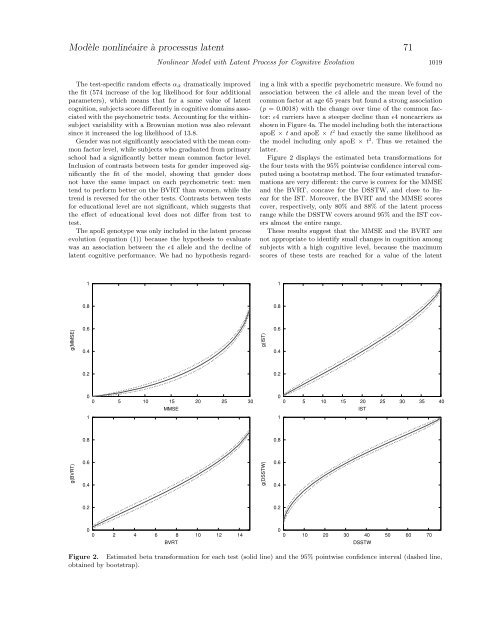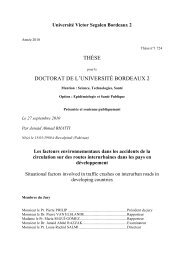Télécharger le texte intégral - ISPED-Enseignement à distance
Télécharger le texte intégral - ISPED-Enseignement à distance
Télécharger le texte intégral - ISPED-Enseignement à distance
- No tags were found...
You also want an ePaper? Increase the reach of your titles
YUMPU automatically turns print PDFs into web optimized ePapers that Google loves.
Modè<strong>le</strong> nonlinéaire <strong>à</strong> processus latent 71Nonlinear Model with Latent Process for Cognitive Evolution 1019The test-specific random effects α ik dramatically improvedthe fit (574 increase of the log likelihood for four additionalparameters), which means that for a same value of latentcognition, subjects score differently in cognitive domains associatedwith the psychometric tests. Accounting for the withinsubjectvariability with a Brownian motion was also re<strong>le</strong>vantsince it increased the log likelihood of 13.8.Gender was not significantly associated with the mean commonfactor <strong>le</strong>vel, whi<strong>le</strong> subjects who graduated from primaryschool had a significantly better mean common factor <strong>le</strong>vel.Inclusion of contrasts between tests for gender improved significantlythe fit of the model, showing that gender doesnot have the same impact on each psychometric test: mentend to perform better on the BVRT than women, whi<strong>le</strong> thetrend is reversed for the other tests. Contrasts between testsfor educational <strong>le</strong>vel are not significant, which suggests thatthe effect of educational <strong>le</strong>vel does not differ from test totest.The apoE genotype was only included in the latent processevolution (equation (1)) because the hypothesis to evaluatewas an association between the ɛ4 al<strong>le</strong><strong>le</strong> and the decline oflatent cognitive performance. We had no hypothesis regard-ing a link with a specific psychometric measure. We found noassociation between the ɛ4 al<strong>le</strong><strong>le</strong> and the mean <strong>le</strong>vel of thecommon factor at age 65 years but found a strong association(p = 0.0018) with the change over time of the common factor:ɛ4 carriers have a steeper decline than ɛ4 noncarriers asshown in Figure 4a. The model including both the interactionsapoE × t and apoE × t 2 had exactly the same likelihood asthe model including only apoE × t 2 . Thus we retained thelatter.Figure 2 displays the estimated beta transformations forthe four tests with the 95% pointwise confidence interval computedusing a bootstrap method. The four estimated transformationsare very different: the curve is convex for the MMSEand the BVRT, concave for the DSSTW, and close to linearfor the IST. Moreover, the BVRT and the MMSE scorescover, respectively, only 80% and 88% of the latent processrange whi<strong>le</strong> the DSSTW covers around 95% and the IST coversalmost the entire range.These results suggest that the MMSE and the BVRT arenot appropriate to identify small changes in cognition amongsubjects with a high cognitive <strong>le</strong>vel, because the maximumscores of these tests are reached for a value of the latent110.80.8g(MMSE)0.60.4g(IST)0.60.40.20.200 5 10 15 20 25 30MMSE100 5 10 15 20 25 30 35 40IST10.80.8g(BVRT)0.60.4g(DSSTW)0.60.40.20.200 2 4 6 8 10 12 14BVRT00 10 20 30 40 50 60 70DSSTWFigure 2. Estimated beta transformation for each test (solid line) and the 95% pointwise confidence interval (dashed line,obtained by bootstrap).
















